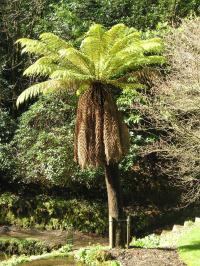Nurturing a Dicksonia antarctica (Tree Fern)
 Tree ferns are one of the oldest plants in the world
Tree ferns are one of the oldest plants in the worldHelpful advice about tree ferns and the importance of patience when waiting for the end of their dormant period.
Many moons ago I was lucky enough to see tree ferns growing in a coastal forest in New Zealand. Ever since that wonderful trip, Dicksonia antarctica has been on my shopping list, but with prices for sizeable specimens being equally sizeable, I could never bring myself to part with a Jurassic sized wad to pay for this very Jurassic looking fern.
So you can imagine my excitement at finding a huge Dicksonia antarctica at my local hardware chain for a relatively small sum. Since all the ferns there were priced equally, I let greed get the better of me and selected the largest one, which seemed to weigh in at close to 50 kilos and measured a good 3’6" tall and a foot in diameter. Worried by its dry and flaky condition and with no visible fiddle heads to reassure me, I secured a thirty day guarantee with the shop and wrestled the monster home. Little did I know that my guarantee would serve only to place me in a difficult dilemma further down the line.
Before buying the fern, I did a little reading on how to care for it and what to expect when. I hoped that a wet regime of constant watering would undo the potential damage of days, perhaps weeks, in dry transit and storage. I collected the ericaceous materials beloved by such ferns, planted it in a large tub and waited, nursing my back, for late spring when my tree fern would sit in the partial shade of my gazebo roof and make me happy.
I waited and watered with lime free rainwater from my water butt. Nothing happened. If anything my tree fern began to look deader than ever. Research on the internet proved fruitless. Beyond the effects of frost, little was written about Dicksonia antarctica’s problem points. The expected time for a joyous crown of huge ferns was fast fading. And on the day of my deadline for returning the tree for a refund, I called a local nursery where I knew they sold these specimens.
This was the dilemma, the knowledgeable nursery man advised me that although these ferns generally began to show signs of life by mid to late spring, it was not unusual to have to wait until mid June before being able to feel the arches of the folded fronds deep inside the centre of the crown. Only by mid June, some six weeks away, would I know whether or not my purchase had been the bargain of the century or a spectacular mistake. It was having had this conversation that I effectively placed my £40 each way bet on my Dicksonia antarctica surviving. It came down to emotion. I wanted my giant friend to be a success more than I wanted to hurt my back and regain four crisp tenners. My bid was in, failure was not an option.
Four weeks later the green stumps of past ferns had gone brown and I sincerely believed that my finger tips had touched a horticultural mirage when I felt deep inside the crown and thought I had discovered some evidence of life. Outwardly, nothing had changed. Had I bought the cat an expensive, Jurassic looking scratching post? Deflated, I drove off to Cumbria to lose my sorry self in the lakes.
Well you can imagine my surprise when I returned. One week of warmth and rain and a sea change had occurred in the crown of Dicksie. The auburn hairs deep in the central bowl of the crown had begun to spike up. The surface boiled with rising fiddle heads, four massive leviathans rising from a stormy sea. I jumped for joy!
I never believed that my garden would ever have sent me on such an emotional roller coaster of tough choices, but a dormant Dicksonia antarctica provided me with all these. Better late than never? More like never again!
For more information see:
Dicksonia antarctica
Filed under General.

